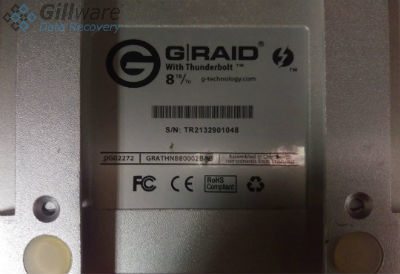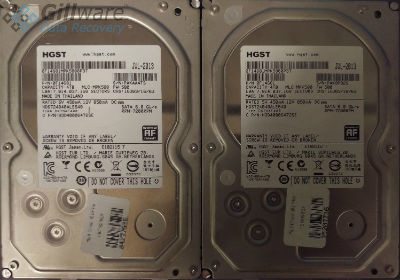G-RAID Data Recovery Case Study: 8 TB RAID-0 External G-Technology Enclosure
In this case study, the client had been using a G-RAID enclosure as an external device for their Mac Pro. There were two four-terabyte Hitachi hard drives inside the enclosure. A RAID-0 array connected the two drives. The client used this eight-terabyte RAID-0 array to store their documents and photos. When the drives in the array failed to spin up one day, the client brought the G-RAID to us for data recovery. Our data recovery experts were able to successfully recover the client’s files in this G-RAID data recovery case.

G-RAID Data Recovery Case Study: 8 TB RAID-0 External G-Technology Enclosure
Drive Brand/Model: Hitachi HDS724040ALE640
RAID Enclosure Model: G-Technology G-RAID GRATHNB80002BAB
Total Capacity: 8 TB
Operating System: Mac
Situation: RAID controller board died
Type of Data Recovered: Documents and Pictures
Binary Read: 100%
Gillware Data Recovery Case Rating: 10
RAID-0 is a very simple way to connect two or more hard drives together. The hard drives in the array are “striped” together. Each drive contributes the whole of its capacity to one massive, unified storage volume. Since the data gets chopped up and placed onto multiple drives, whenever the user needs to read a file, the array can access multiple disks at once. This boosts read/write speeds.
Every hard drive has several major points of failure. Its motor, read/write heads, platters, and control board can all fail. Multiple components may even fail simultaneously. Two hard drives together have twice as many points of failure. Three hard drives have three times as many failure points. RAID arrays such as RAID-5 have redundant parity data in case one drive fails, cutting down on failure points. But RAID-0 has no fault tolerance.
G-RAID Data Recovery
When you look at the number of failure points in a RAID-0, you don’t just add up the number of failure points from each drive. There is another failure point people do not always think to consider, and that is the RAID controller itself.
Inside the client’s stylish, burnished-metal G-RAID enclosure, a controller board connected the two hard drives. This controller board actually did all the hard work of the RAID array. It stripes the drives together. It breaks incoming data apart and stitches outgoing data together. And it makes the two drives appear to be a single volume. Like any other device, a RAID controller board can fail just as well. Therefore, a two-drive RAID-0 array is actually more than twice as likely as a single hard drive to fail.
The client in this G-RAID data recovery case had two healthy hard drives. But because the RAID controller had burned out, the drives were useless to them. Since the data on each drive was broken up into stripes, each individual hard drive would appear to any other computer to be filled with gibberish. The RAID controller uses metadata on the drives to make sense of the data on them. The way the metadata is written onto the drives is unique to each RAID controller. There’s no way a different model of controller board can interpret the metadata properly.
G-RAID enclosures are not meant to be opened up by the user—or, at least, not without voiding the warranty. These enclosures, by design, offer users RAID functionality without the need to voyage into the complicated world of RAID setup and maintenance. They are simple and easy to set up. The client could not get into the G-RAID to replace the failed controller, or even remove the drives by themselves.
Conclusion

In this G-RAID data recovery case, our data recovery experts had to remove the two drives from the G-RAID enclosure. After a cursory examination by our engineers, we could confirm that both drives were completely healthy, as the client had suspected. After making complete forensic disk images of both drives, we sent them to our RAID experts for the next phase in the data recovery process.
In order to connect the hard drives in a RAID together without the original RAID controller, our RAID experts need software to emulate the controller. Since each controller works slightly differently, our RAID recovery experts usually need to write custom emulation software for each different model of RAID setup that comes our way. Our RAID data recovery experts reverse-engineer this emulation software from the metadata on the drives themselves.
Once our RAID engineers had successfully connected the recovered disk images, we could see how much of the client’s data was safe and sound. We determined that all of the client’s documents and photos were completely recovered. Analysis of the G-Drive data recovery case results showed no noticeable file corruption among the client’s critical data. We rated this G-Drive data recovery case a 10 on our ten-point data recovery case rating scale.
